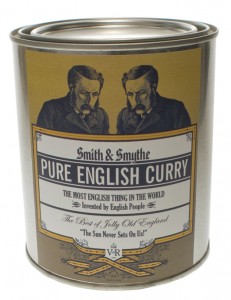Good as some bottled curry sauces are, the satisfaction and control available to anyone willing to put in the effort to produce their own is well worth the while. The cooking smells are compensation enough on their own.
Here’s a basic route, and a more involved one.
Basic Curry Sauce
Take a couple of chopped onions, a couple of chopped garlic cloves and about a third of a litre of stock. Stir in some ground spices – a large spoonful of cumin, coriander and paprika, a couple of pinches each of allspice, cardamon and ginger, and a teaspoon or so of cayenne. Boil this mixture for between five and ten minutes, then chop and add a couple of peppers, a couple of large carrots, and a couple of handfuls of ordinary button mushrooms. Simmer until the vegetables give at the point of a knife and the mixture is reduced. Puree the mixture in a blender, or simply use as it is.
You’ll be able to cook chicken in this sauce in the usual way, or vegetables of your choice – if there’s not enough liquid, add a little stock as you go.
A Classic Curry Sauce
This is a 3-step process, as described in Pat Chapman’s essential The New Curry Bible (2006)* (asterisk denotes an affiliate link. If you buy through this link, the Laughing Garreteer will benefit).
Step One: Make Garam Masala.
In a pan, roast – do not burn! the following:
60g coriander seeds
50g cumin seeds
40g fennel seeds
25g black peppercorns
15g cloves
15g brown cardamons
3 pieces mace
25g cassia bark pieces
4 bay leaves
Allow the mixture to cool, then grind it in small batches, either in an electric grinder (e.g. a coffee grinder) or in a pestle and mortar. Then stir in 5g of ground ginger. The resulting Garam Masala will keep in a jar for months, but will eventually lose its flavour.
Step Two: Make Curry Masala
Mix 20g of the Garam Masala with the following ground spices:
60g coriander
30g cumin
20g fenugreek
25g gram flour
25g garlic powder
20g paprika
20g turmeric
5g bay leaf
5g asafoetida
5g ginger
5g chilli powder
5g English yellow mustard powder
5g black pepper
5g cinnamon
It’s not worth worrying if some of the spices aren’t available to you – just readjust the portions and carry on.
Again, you can keep this mixture jarred for some time, but it will eventually lose its savour.
Step 3: Make Curry Gravy
Pat Chapman regards this as “Medium” Curry Gravy. It’s one of the basic starter recipes in The New Curry Bible.*
Add enough water to 2 tablespoons of curry masala to make a paste. Heat a couple of tablespoons of ghee in a wok (olive oil will do at a pinch, although ghee lasts well in the fridge) and add the paste. Fry until you see the oil begin to float. Add 50g of chopped garlic and fry for another minute, then reduce the heat. Add 250g of chopped Spanish onion, and fry until browned (according to Chapman, this is the tarka). Add 4 canned tomatoes and 200ml water, and blend to a purée. Add 2 tablespoons of chopped green bell pepper, then simmer for ten minutes. Salt to taste.
This gravy should keep without difficulty in the fridge for a few days, but is ready for immediate use with chicken, prawns, vegetables etc.
At first sight, this is a complex procedure – albeit a highly enjoyable one – but it’s simple in fundamentals and open to personalization and adaptation. At any rate, it will soon become second nature. And playing with large quantities of spices is fun…

